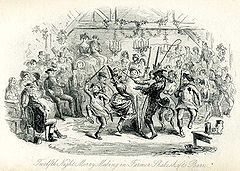| Twelfth Night | |
|---|---|
 Mervyn Clitheroe's Twelfth Night party, by "Phiz" | |
| Also called | Epiphany Eve |
| Observed by | Christians, people living in culturally Christian countries |
| Type | Christian, cultural |
| Significance | evening prior to Epiphany |
| Observances |
|
| Date | 5, 6, or 17 January |
| Frequency | annual |
| Related to | |
Twelfth Night (also known as Epiphany Eve depending upon the tradition) is a Christian festival on the last night of the Twelve Days of Christmas, marking the coming of the Epiphany.[1] Different traditions mark the date of Twelfth Night as either 5 January or 6 January, depending on whether the counting begins on Christmas Day or 26 December.[2][3][4] January 6 is celebrated as the feast of Epiphany, which begins the Epiphanytide season.[5][6]
A superstition in some English-speaking countries suggests it is unlucky to leave Christmas decorations hanging after Twelfth Night, a tradition also variously attached to Candlemas (which marks the end of Epiphanytide on 2 February), as well as Good Friday, Shrove Tuesday, and Septuagesima.[7] Other popular customs include eating king cake, singing Christmas carols, chalking the door, having one's house blessed, merrymaking, and attending church services.[8][9]
- ^ Cite error: The named reference
Hatch1978was invoked but never defined (see the help page). - ^ "Epiphany: Should Christmas decorations come down on 6 January?". BBC News. 6 January 2017. Retrieved 9 January 2021.
- ^ Carter, Michael. "Why it is time for an epiphany over Christmas decorations". The Tablet. Retrieved 9 January 2021.
- ^ "The roots and traditions of Nollaig na mBan".
- ^ "Epiphany: Should Christmas decorations come down on 6 January?". BBC News. 6 January 2017.
The Church of England celebrates the season of Epiphany from 6 January to 2 February.
- ^ Arcadi, James M. (2 February 2021). "Candlemas for the Souls". All Souls Anglican Church.
The Feast of the Presentation is considered by many to be the close of the Christmas to Epiphany Season.
- ^ William Alexander Barrett (1868). Flowers and Festivals, Or, Directions for the Floral Decoration of Churches. Rivingtons. pp. 170–174.
- ^ Mangan, Louise; Wyse, Nancy; Farr, Lori (2001). Rediscovering the Seasons of the Christian Year. Wood Lake Publishing Inc. p. 69. ISBN 9781551454986.
Epiphany is often heralded by "Twelfth Night" celebrations (12 days after Christmas), on the evening before the Feast of Epiphany. Some Christian communities prepare Twelfth Night festivities with drama, singing, rituals - and food! ... Sometimes several congregations walk in lines from church to church, carrying candles to symbolize the light of Christ shining and spreading. Other faith communities move from house to house, blessing each home as they search for the Christ child.
- ^ Pennick, Nigel (21 May 2015). Pagan Magic of the Northern Tradition: Customs, Rites, and Ceremonies. Inner Traditions – Bear & Company. p. 176. ISBN 9781620553909.
On Twelfth Night in German-speaking countries, the Sternsinger ("star singers") go around to houses carrying a paper or wooden star on a pole. They sing an Epiphany carol, then one of them writes in chalk over the door a formula consisting of the initials of the Three Wise Men in the Nativity story, Caspar, Melchior, and Balthasar, with crosses between them and the year date on either side; for example: 20 +M+B 15. This is said to protect the house and its inhabitants until the next Epiphany.